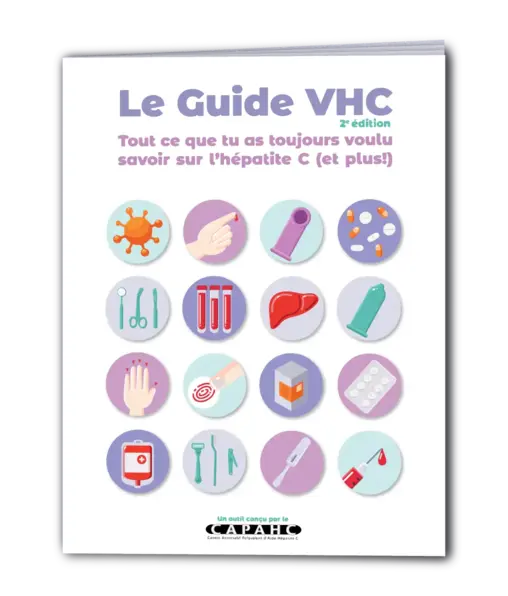Your reference for hepatitis C in Quebec
VHC &…
Alcohol can be hepatotoxic. Its consumption reduces the rates of spontaneous HCV clearance and can seriously aggravate the evolution of liver disease for people living with HCV.
For people living with HCV, consuming alcohol accelerates the progression of fibrosis, increases the risk of advanced fibrosis/cirrhosis and decompensated cirrhosis, increases the risk of liver cancer (particularly at a younger age and limiting response to treatment) and increases the risk of death.
For people living with HCV, consuming alcohol accelerates the progression of fibrosis, increases the risk of advanced fibrosis/cirrhosis and decompensated cirrhosis, increases the risk of liver cancer (particularly at a younger age and limiting response to treatment) and increases the risk of death.
The severity of the impact depends on the quantity of alcohol absorbed and the frequency of consumption. According to one study, the impact is significant when 14 or more units of alcohol are consumed per week. For people who consume alcohol, the risks of decompensated cirrhosis and death remain even after DAA treatment in comparison with people who do not. 1
As previously stated, people who use drugs (injected or not) are among those most affected by HCV. Infection modeling indicates that in “industrialized” countries, 70-80% of new HCV infections will be people who use drugs via injection. Current or past drug consumption does not impede the efficacy of DAA treatment. All related studies demonstrate similar efficacy for DAA for people who consume psychoactive substances and the rest of the population. There are no interactions between DAA treatment and opioid agonist therapy (OAT). Cocaine, however, can be hepatotoxic and the consumption of stimulants may have an effect on adherence to treatment.
It should also be highlighted that stigmatization faced by people who use drugs is a barrier to accessing care and other services.
Considering the risks of reinfection for people who inject drugs, the most important measures are prevention, education and expanding access to safe injection materials. If reinfection occurs, treatment must be provided without judgment.
Vertical transmission is the principal cause of pediatric hepatitis C (approximately 60% of global cases). According to one meta-analysis, the risk of vertical transmission is estimated at 5.8%. The risk rises to 10% if the parent is living with an HIV/HCV co-infection.
Breastfeeding is considered safe for people living with HCV, except in cases where nipples are cracked and bleeding. Certain studies report that HCV leads to an increased risk of gestational diabetes, Intrahepatic cholestasis of pregnancy (ICP), premature birth and low birth weight.
Data is limited about the effects of DAA treatment during pregnancy (accidental or intentional). Currently, DAA treatment is not recommended during pregnancy or breastfeeding due to the lack of data about its safety. It is important to consider the implications for pregnant people who are diagnosed with HCV without treatment options before giving birth or finishing breastfeeding.
The prevalence of HCV in children is lower than that of adults, though it is estimated that between 3.5-5 million children are living with chronic hepatitis C. In order to screen children for hepatitis C, an antibody test is conducted after 18 months (testing before this age carries the risk of detecting antibodies from the parent instead). In order to test before 18 months or during breastfeeding, RNA analysis is required.
If an antibody screening returns a positive result, the next step is RNA analysis at three years old because 50% of children will go through spontaneous HCV clearance. Since June 2022, the MaviretTM treatment has been authorized by the Public Health Agency of Canada for children aged three years and older. Treatment lasts eight weeks and has an efficiency rate of 98.4%. The pediatric MaviretTM is dispensed in unit-dose packets of oral pellets to make ingestion easier for children.
Worldwide, the prevalence of HBV/HCV coinfection is unknown. HBV/HCV coinfection is associated with higher rates of cirrhosis, increased severity of hepatic disease and a higher risk of HCC compared to those infected with only HBV or HCV. Treatment for coinfected people is complex due to the interactions between the viruses and the potential reactivation of either virus during antiviral treatment.
The American Association for the Study of Liver Diseases (AASLD) recommends beginning hepatitis B treatment at the same time as, or even before, DAA treatment for people with a coinfection. Regular follow ups are necessary to evaluate whether either of the two viruses will reactivate. HBV/HCV coinfection does not affect the recovery rate of HCV by DAA treatment.
Worldwide, it is estimated that 2.3 million people live with HIV/HCV coinfection, majoritarily affecting PWID and GBMSM populations. The risk of HCV is six times higher for people living with HIV compared to those without. In Canada this coinfection affects 20-30% of people living with HCV and is responsible for a heavy burden of morbidity and mortality.
People living with HIV/HCV coinfection face a risk of accelerated fibrosis progression, a greatly increased risk of hepatocellular carcinoma and a high risk of mortality compared to people with HCV mono infection, even when taking antiretroviral (ARV) treatment. HCV impacts the progression of HCV, notably facilitating its replication.
Recent studies indicate that the SVR for people with HIV/HCV coinfection are comparable to those with HCV monoinfection.
It is recommended to begin with antiretrovirals and to only start DAA treatment once the HIV virus is undetectable.
It has been observed that among people infected with COVID-19, those who have had a previous HCV infection are additionally subjected to a higher virulence of SARS CoV-2, independently of base comorbidities, or to hepatic lesions induced by COVID-19.
People living with chronic hepatitis C have a greater risk of hospitalization due to SARS-CoV-2 and the hospitalization rate increases with a FIB-4 score. The presence of HCV does not, however, have a significant impact on rates of admission to intensive care or mortality.
Patients with cirrhosis of the liver are susceptible to complications or death due to COVID-19.
Beyond increasing severity of illness for people living with HCV, the COVID-19 pandemic has also impacted access to care and hepatitis C services at all levels of the cascade of care, particularly for key communities, including people who use drugs. The report on the effects of COVID-19 on the provision of screening and treatment for STBBIs in Canada demonstrated that “The reduction and suspicion of services affected the provision of prevention services, screening and treatment for STIs, including support and treatment for people living with HIV and/or hepatitis C.”
Rappelons-nous aussi la mise en place de deux couvre-feux au Québec ainsi que la criminalisation disproportionnée des communautés marginalisées durant la pandémie, particulièrement au Québec, qui ont entravé l’accès aux soins et services, notamment en réduction des méfaits. La pandémie a donc ralenti les efforts d’élimination du VHC.
It has also been observed that the groups most disproportionately affected by HCV were particularly affected by COVID. The pandemic exacerbated existing issues and worsened social inequalities. Efforts should be redoubled in order to address barriers associated with stigmatization, discrimination, poverty and with the overdose and housing crises.
La pandémie de COVID-19 a également créé des opportunités d’innovation en termes de santé telle que l’accroissement de la télémédecine, qui constitue un moyen d’accroître l’engagement des communautés les plus marginalisées. À voir si les gouvernements sauront s’en saisir.





